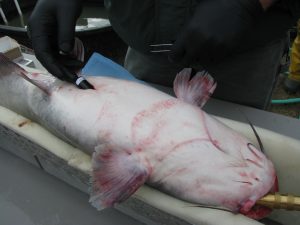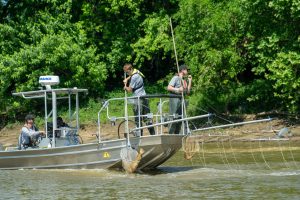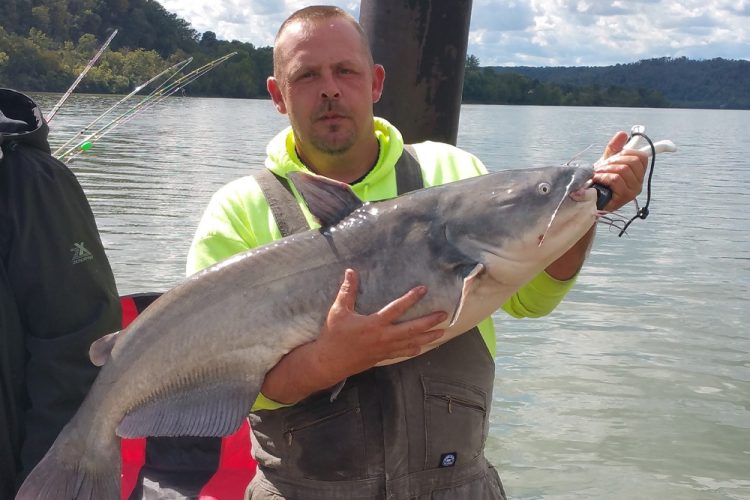Kevin Walters shows a nice blue catfish he caught in the Ohio River. (credit: Kevin Walters)
The Ohio River’s Catfish Bounty
By Anietra Hamper
New research highlights how catfish migrate along the Ohio River’s segmented pools.
Kevin Walters grew up fishing for catfish on the Ohio River and still spends as much time as he can on the water.
“I would always come down to my grandmother’s house,” he said. “She lived right on the banks of the Ohio River. I mean, literally, it was at the front porch. I would take off and just fish with whatever I could find, like nuts and bolts and random things to tie on the line for sinkers.”
Walters’ lifetime of experience fishing the Ohio River inspired him to start a terminal-tackle business called Monster Cat Catfishing that he runs alongside his day job as a firefighter and paramedic. He wants to help other anglers be successful at catching the trophy catfish that the river is known for. But he wants them to enjoy the surrounding nature and wildlife while doing it.
“I always used fishing as an outlet emotionally and spiritually to get away from the job and forget about it,” Walters said. “When I’m out and about fishing, it’s like everything else just goes away, you know?”

The Ohio River extends 981 miles bordering Pennsylvania, West Virginia, Kentucky, Ohio, Indiana and Illinois. It offers some of the best trophy blue and flathead catfish fishing in America’s heartland and in the United States.
“In just about any section of the Ohio River, you can find trophy catfish,” said Walters.
Though the Ohio River is where plenty of personal bests are caught, little is known about how catfish live and migrate in this expansive river system.
“We really didn’t know a lot about catfish in the Ohio River in terms of how many there were, how many there are, how long they live, how fast they grow, where they move and what kind of habitats they use,” said Jeremy Pritt, fisheries biologist with the Inland Fisheries Unit of the Ohio Department of Natural Resources, Division of Wildlife. “In a big river system like the Ohio, you have big, long-lived fish in a large waterway, so it’s tough to study these things and learn what you need to about them in traditional ways.”
An eight-year study by the Ohio Department of Natural Resources sheds new light on how blue and flathead catfish migrate throughout the Ohio River. The study has helped uncover what scientists are most curious about: do catfish stay confined to specific pools, or do they migrate?
To find answers, fisheries biologists focused on one of the most productive trophy catfish pools in the Ohio River—the Meldahl Pool, which covers a 95-mile stretch between Meldahl Dam and Greenup Dam in southwest Ohio. Researchers implanted acoustic telemetry transmitters into a sampling of blue and flathead catfish. The transmitters send out acoustic signals every few minutes to receivers placed along sections of the research corridor.
What researchers discovered is that both blue and flathead catfish are highly mobile and capable of traveling long distances. The blue catfish studied traveled an average of 20 to 30 miles in a year and flathead catfish about half of that. Some catfish, though, logged over 100 miles of movement in a single calendar year.

The biggest surprise from the study is not how far or how often the catfish migrated but that they traveled up and downstream from the dams. This gives important insight into what kind of movement might be happening along the Ohio River’s navigational pools, which are segmented by 20 locks and dams.
“They go upstream and downstream a lot. The blue catfish especially were able to go back and forth at the Meldahl Dam,” said Pritt.
Some of the movement over dams happened under low flow conditions and some under higher flow conditions, so their patterns were irregular, making it even more difficult for researchers to understand the fishes’ migration motivations.
Since flathead catfish can live almost 40 years and blue catfish over 30 years, the research supports that, with their migration patterns, they are able travel long distances to take advantage of the hundreds of miles of habitat in the Ohio River.
Pritt says anglers can leverage this research by understanding more about how the catfish utilize the river system. In late spring and summer (May and June) with frequent high flow events, the fish move up into tributaries like the Scioto River, in the upper parts of the pool and near the dams.
In summer, when flow is lower, the fish move to middle and lower sections of the pools into deeper, slower water.
“Understanding those seasonal movements and where fish are at different times of the year can help anglers narrow in on where to try to locate fish in the expanse of the Ohio River,” said Pritt.
The middle stretch of Meldahl Pool is where Walters spends most of his time fishing.
While it is a popular and productive segment in the Ohio River there are other notable segments for anglers to enjoy including the Markland Pool in Cincinnati, Ohio; Newburgh Pool outside of Owensboro, Kentucky; Robert C. Byrd Pool in Gallipolis, West Virginia; and the Cannelton Pool in Cannelton, Indiana.
Whether it’s the trophy catfish or just the natural stillness and wildlife, the Ohio River has a way of calling anglers back time and time again.
“The size of the fish doesn’t always matter. Obviously, we all want to catch big trophy-sized fish, but the best thing is just being out there and being at one with the waterway and with nature enjoying what God’s given us,” said Walters.
Given the research, there are lot of opportunities for anglers to experience both.
(Anietra Hamper is a career television news anchor and investigative journalist turned award-winning outdoor writer specializing in fishing and outdoor adventure. Anietra travels the world fishing for catfish and other unique species in new destinations.)



